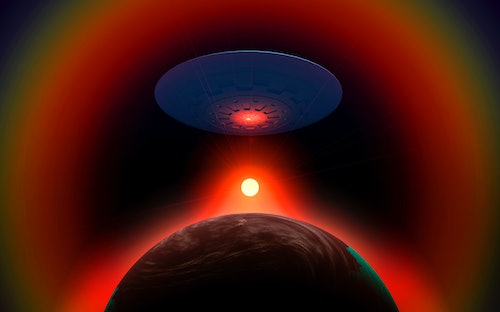The largest SETI search in the world is looking beyond radio. In 2015, Russian-Israeli billionaire Yuri Milner and his non-profit organization, , launched the largest (SETI) project. Known as Breakthrough Listen, this SETI effort relies on the most powerful radio telescopes in the world and advanced analytics to search for potential evidence of technological activity (technosignatures).
The ten-year project will survey the one million stars closest to Earth, the center of our galaxy, the entire galactic plane, and the 100 galaxies closest to the Milky Way. In 2018, they partnered with the (VERITAS) Collaboration, a ground-based system of gamma-ray telescopes operating at the (FLWO) atop Mt. Hopkins in southern Arizona.
In a , the VERITAS Collaboration shared the results of the first year of their search for “optical technosignatures” (from 2019 to 2020). Their results are a vital proof of concept demonstrating how future searches for extraterrestrial civilizations can incorporate optical pulses into their technosignature catalog. The VERITAS Collaboration is an international effort that includes researchers from the FLWO, the (CfA), the , the (DESY) research center, the NASA Goddard Space Flight Center, and multiple universities and research institutes.
The paper that describes their findings, titled “ ,” was recently accepted for publication in . For the past sixty years, beginning with , the search for ETI has been almost exclusively focused on looking for evidence of radio transmissions. In recent years, scientists have been expanding the search to consider other potential technosignatures, which include directed-energy communications, radio and optical leakage from technological civilizations, infrared emissions from megastructures, spectral evidence for industrial pollutants in exoplanet atmospheres, and even spacecraft or debris in our Solar System.
These and other potential examples of extraterrestrial technology were outlined in released in 2018. Incorporating the VERITAS array, which consists of four 12-meter (~40 ft) Cherenkov optical reflectors for gamma-ray astronomy, has allowed Breakthrough Listen to expand its search for optical technosignatures – specifically, for nanosecond optical pulses detectable over interstellar distances. Gregory Foote, a Ph.
D. candidate with the Department of Physics and Astronomy at the University of Delaware (UD) and a co-author on the VERITAS paper, explained to via email: Completed in 2007, the VERITAS array effectively complements NASA’s (FRGST) — and the (LAT) collaboration, of which Fermi is a partner — due to its larger collection area and greater sensitivity to gamma rays. In fact, VERITAS’ segmented mirror telescopes – similar to the ‘s (JWST) primary mirror – have the highest sensitivity of any telescopes in the very-high-energy (VHE) band, with a maximum sensitivity of 100 giga-electronvolts (Gev) to 10 tera-electronvolts (TeV).
These capabilities were tested as the Collaboration team searched through the Breakthrough Listen target catalog for signs of high-energy optical pulses. Said Foote: In addition, the Collaboration team examined VERITAS archival data going back to 2012. The team then calculated which targets from the Breakthrough Listen catalog were observed by VERITAS during the same period.
Because they had limited computation time, they decided to spread the archival analysis across many different targets, analyzing only the first hour of quality data. “This left us with 249 observations of 119 non-overlapping fields containing 140 targets captured serendipitously,” said Foote. “Unfortunately, we did not find evidence for this technosignature from these targets in any of the observations we analyzed.
” While their analysis did not find evidence of any nanosecond optical pulses, the study has provided an important proof-of-concept that will inform future searches. It has also established limits on the number of stars that could be hosting transmitting civilizations, helping narrow these searches and increasing the likelihood of future detections. Beyond that, said Foote, this study could have significant implications for existing gamma-ray observatories and planned ones.
This includes the (PANOSETI), which will conduct coordinated observations with the Veritas Observatory: “I think the biggest impact on the broader field is that this technosignature can be searched for by piggybacking off of existing gamma-ray observatories, including VERITAS, and ones which have yet to be built. This also goes the other way too, as observatories being purpose-built for this technosignature, like PANOSETI, can have some gamma-ray science piggyback off of it. This is a unique intersection between fields which hasn’t been greatly explored until now.
”.
From: inverse
URL: https://www.inverse.com/science/seti-nanosecond-pulses-of-light



